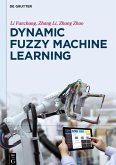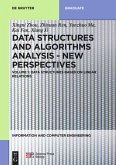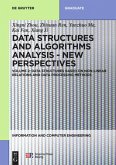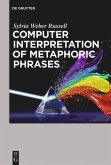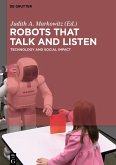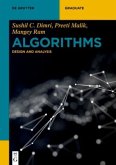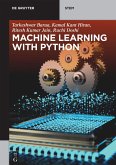This book explains deep learning concepts and derives semi-supervised learning and nuclear learning frameworks based on cognition mechanism and Lie group theory. Lie group machine learning is a theoretical basis for brain intelligence, Neuromorphic learning (NL), advanced machine learning, and advanced artifi cial intelligence. The book further discusses algorithms and applications in tensor learning, spectrum estimation learning, Finsler geometry learning, Homology boundary learning, and prototype theory. With abundant case studies, this book can be used as a reference book for senior college students and graduate students as well as college teachers and scientific and technical personnel involved in computer science, artifi cial intelligence, machine learning, automation, mathematics, management science, cognitive science, financial management, and data analysis. In addition, this text can be used as the basis for teaching the principles of machine learning.
Li Fanzhang
is professor at the Soochow University, China. He is director of network security engineering laboratory in Jiangsu Province and is also the director of the Soochow Institute of industrial large data. He published more than 200 papers, 7 academic monographs, and 4 textbooks.
Zhang Li
is professor at the School of Computer Science and Technology of the Soochow University. She published more than 100 papers in journals and conferences, and holds 23 patents.
Zhang Zhao
is currently an associate professor at the School of Computer Science and Technology of the Soochow University. He has authored and co-authored more than 60 technical papers.
Li Fanzhang
is professor at the Soochow University, China. He is director of network security engineering laboratory in Jiangsu Province and is also the director of the Soochow Institute of industrial large data. He published more than 200 papers, 7 academic monographs, and 4 textbooks.
Zhang Li
is professor at the School of Computer Science and Technology of the Soochow University. She published more than 100 papers in journals and conferences, and holds 23 patents.
Zhang Zhao
is currently an associate professor at the School of Computer Science and Technology of the Soochow University. He has authored and co-authored more than 60 technical papers.
Table of Content:
Chapter 1 Introduction
1.1 Introduction
1.2 Basic concepts in Lie group machine learning
1.3 Aaxiom and hypothesis
1.4 Model
1.5 Dynkin diagram and geometric algorithm
1.6 Classifier design
Chapter 2 Covering learning in Lie group machine learning
2.1 Algorithms and theories
2.2 Single-connected covering learning algorithm
2.3 Multiply-connected covering learning algorithm
2.4 Applications of covering algorithm in molecular docking
2.5 Summary
Chapter 3 Deep learning and structure
3.1 Introduction
3.2 Deep learning
3.3 Layer-by-layer learning algorithm
3.4 Heuristic deep learning algorithm
3.5 Summary
Chapter 4 Lie group semi-supervised learning
4.1 Introduction
4.2 Semi-supervised learning model based on Lie group
4.3 Semi-supervised learning algorithm based on linear Lie group
4.4 Semi-supervised learning algorithm based on nonlinear Lie group
4.5 Summary
Chapter 5 Lie group nuclear Learning
5.1 Matrix group learning and algorithm
5.2 Gauss distribution in Lie group
5.3 Calculation of mean value in Lie group
5.4 Learning algorithm based on Lie group mean
5.5 Nuclear learning and algorithm
5.6 Applications and case studies
5.7 Summary
Chapter 6 Tensor learning
6.1 Data reduction based on tensor
6.2 Data reduction model based on tensor field
6.3 Model and algorithm design based on tensor field
6.4 Summary
Chapter 7 Connection learning based on frame bundle
7.1 Vertical spatial learning model based on frame bundle
7.2 Vertical spatial connection learning model based on frame bundle
7.3 Horizontal spatial learning model based on frame bundle
7.4 Horizontal and vertical special algorithms based on frame bundle
7.5 Summary
Chapter 8 Spectrum estimation learning
8.1 Concepts and definitions in spectral estimation
8.2 Theoretical foundations
8.3 Synchronous spectrum estimation learning algorithm
8.4Comparison of image features manifold
8.5 Spectrum estimation learning algorithm with topological invariant image feature manifolds
8.6 Clustering algorithm with topological invariant image feature manifolds
8.7 Summary
Chapter 9 Finsler geometry learning
9.1 Basic concepts
9.2 KNN algorithm based on Finsler metric
9.3 Geometric learning algorithm based Finsler metrics
9.4 Summary
Chapter 10 Homology boundary learning
10.1 Boundary learning algorithm
10.2 Boundary partitioning based on homology algebra
10.3 Design and analysis for homology boundary learning algorithm
10.4 Summary
Chapter 11 Learning based on prototype theory
11.1 Introduction
11.2 Prototype representation for learning expression
11.3 Mapping for the learning expression
11.4 Classifier design for the mapping for learning expression
11.5 Case Study
11.6 Summary
References
Chapter 1 Introduction
1.1 Introduction
1.2 Basic concepts in Lie group machine learning
1.3 Aaxiom and hypothesis
1.4 Model
1.5 Dynkin diagram and geometric algorithm
1.6 Classifier design
Chapter 2 Covering learning in Lie group machine learning
2.1 Algorithms and theories
2.2 Single-connected covering learning algorithm
2.3 Multiply-connected covering learning algorithm
2.4 Applications of covering algorithm in molecular docking
2.5 Summary
Chapter 3 Deep learning and structure
3.1 Introduction
3.2 Deep learning
3.3 Layer-by-layer learning algorithm
3.4 Heuristic deep learning algorithm
3.5 Summary
Chapter 4 Lie group semi-supervised learning
4.1 Introduction
4.2 Semi-supervised learning model based on Lie group
4.3 Semi-supervised learning algorithm based on linear Lie group
4.4 Semi-supervised learning algorithm based on nonlinear Lie group
4.5 Summary
Chapter 5 Lie group nuclear Learning
5.1 Matrix group learning and algorithm
5.2 Gauss distribution in Lie group
5.3 Calculation of mean value in Lie group
5.4 Learning algorithm based on Lie group mean
5.5 Nuclear learning and algorithm
5.6 Applications and case studies
5.7 Summary
Chapter 6 Tensor learning
6.1 Data reduction based on tensor
6.2 Data reduction model based on tensor field
6.3 Model and algorithm design based on tensor field
6.4 Summary
Chapter 7 Connection learning based on frame bundle
7.1 Vertical spatial learning model based on frame bundle
7.2 Vertical spatial connection learning model based on frame bundle
7.3 Horizontal spatial learning model based on frame bundle
7.4 Horizontal and vertical special algorithms based on frame bundle
7.5 Summary
Chapter 8 Spectrum estimation learning
8.1 Concepts and definitions in spectral estimation
8.2 Theoretical foundations
8.3 Synchronous spectrum estimation learning algorithm
8.4Comparison of image features manifold
8.5 Spectrum estimation learning algorithm with topological invariant image feature manifolds
8.6 Clustering algorithm with topological invariant image feature manifolds
8.7 Summary
Chapter 9 Finsler geometry learning
9.1 Basic concepts
9.2 KNN algorithm based on Finsler metric
9.3 Geometric learning algorithm based Finsler metrics
9.4 Summary
Chapter 10 Homology boundary learning
10.1 Boundary learning algorithm
10.2 Boundary partitioning based on homology algebra
10.3 Design and analysis for homology boundary learning algorithm
10.4 Summary
Chapter 11 Learning based on prototype theory
11.1 Introduction
11.2 Prototype representation for learning expression
11.3 Mapping for the learning expression
11.4 Classifier design for the mapping for learning expression
11.5 Case Study
11.6 Summary
References


